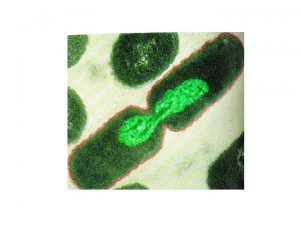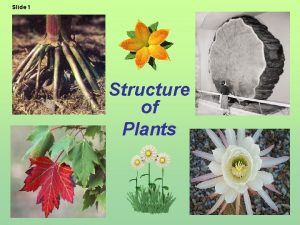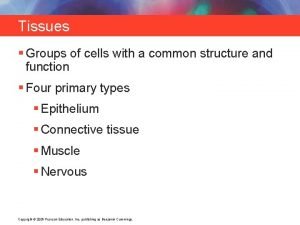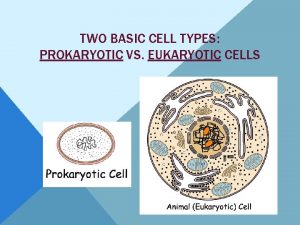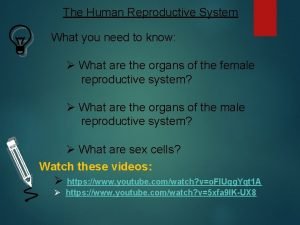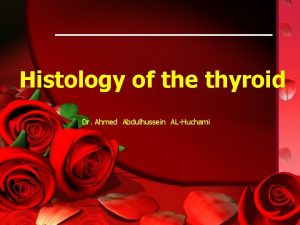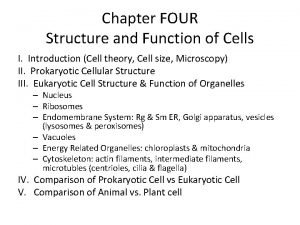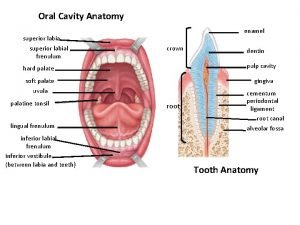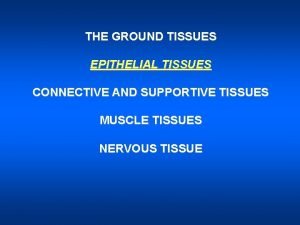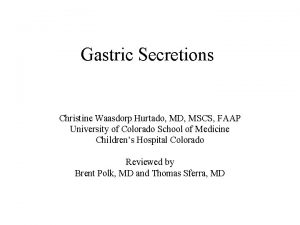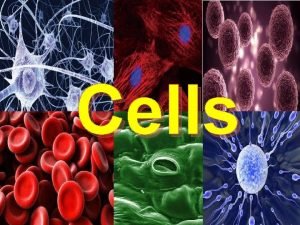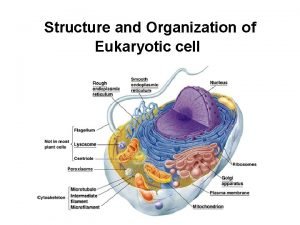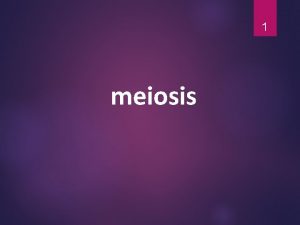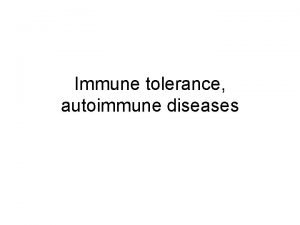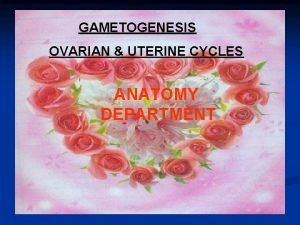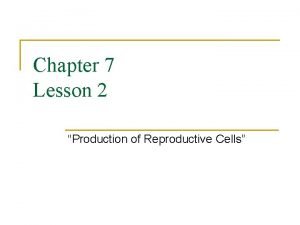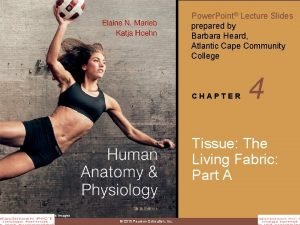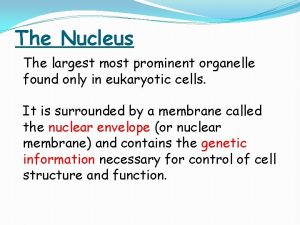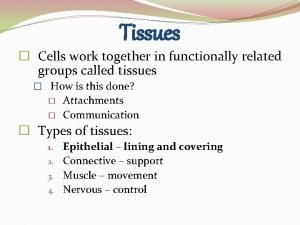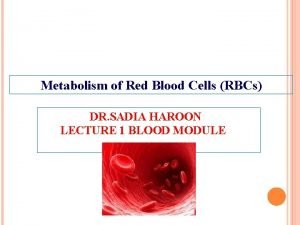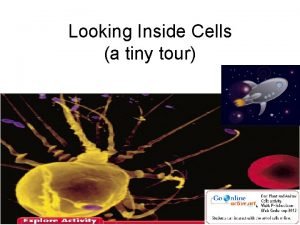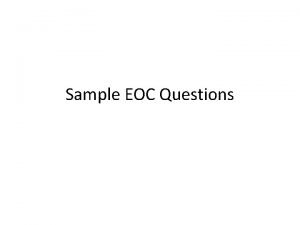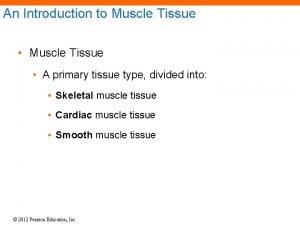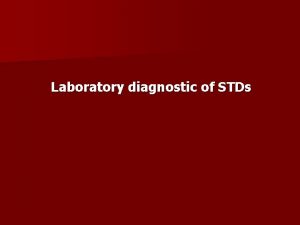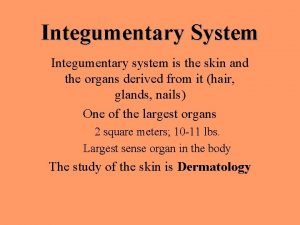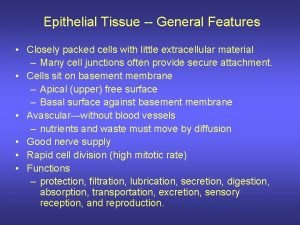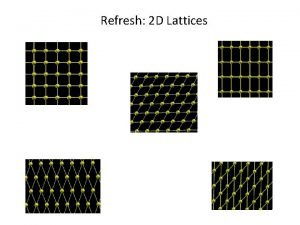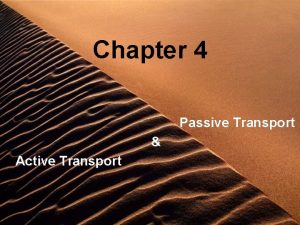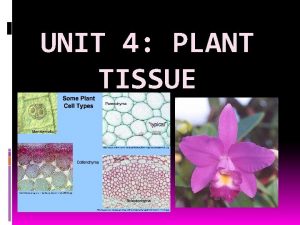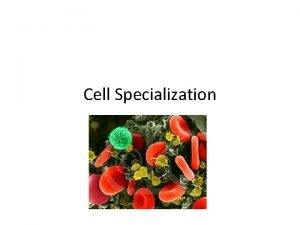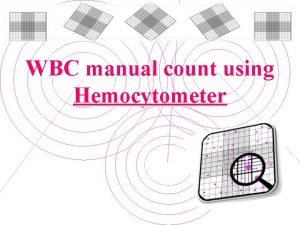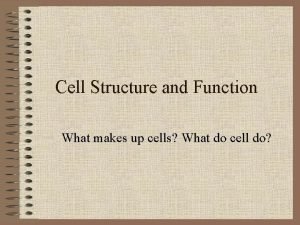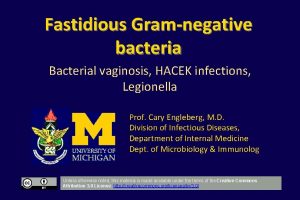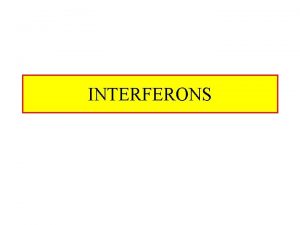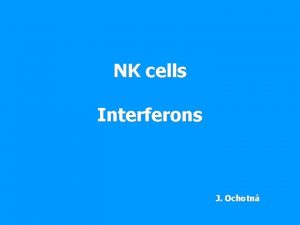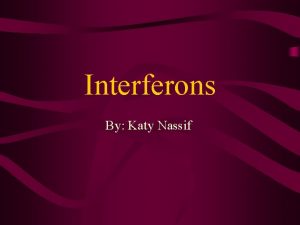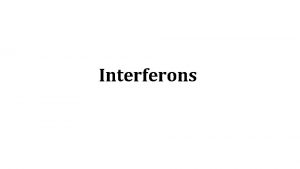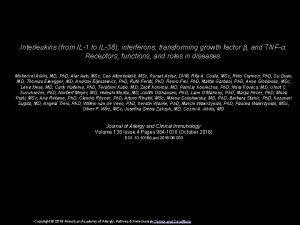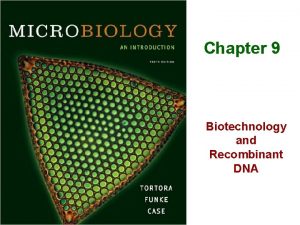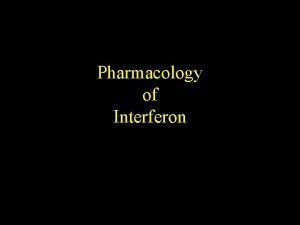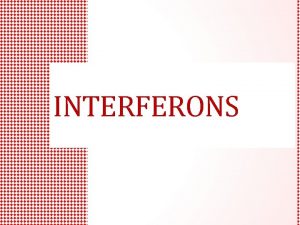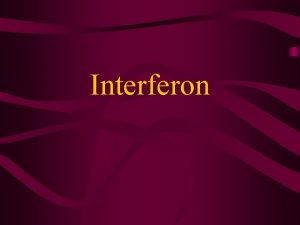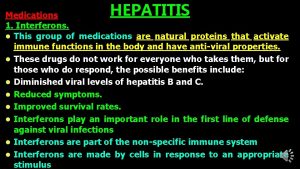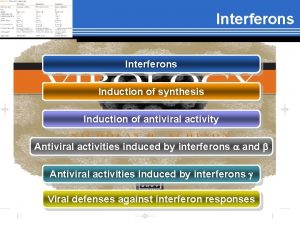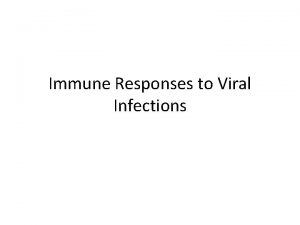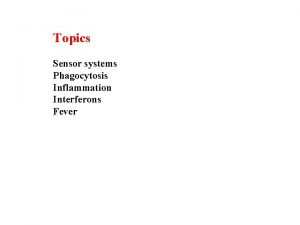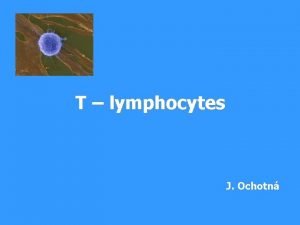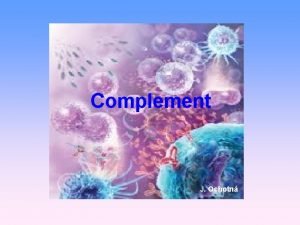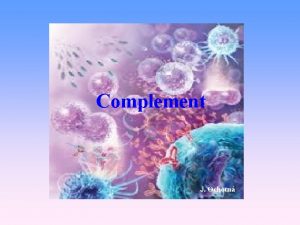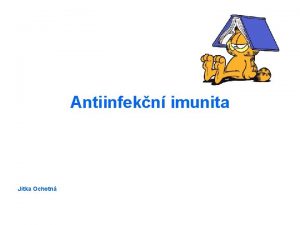NK cells Interferons J Ochotn NK cells Part

































































- Slides: 65

NK cells Interferons J. Ochotná

NK cells § Part of antigen non-specific mechanisms (innate) § They do not have antigen-specific receptors § Recognize cells that have abnormally low MHCgp. I expression (some tumor and virus infected cells) § They are able to kill quickly - without prior stimulation, proliferation and differentiation § Activators of NK cells - IFNa, IFN

NK cells receptors § Activating receptors - Some surface lectins, Fc receptor CD 16 ADCC (antibody-dependent cellular cytotoxicity) NK cells recognize cell opsonized Ig. G antibody through the Fc receptor CD 16, this leads to the activation of cytotoxic mechanisms (NK degranulation) § Inhibitory receptors - Signals provided through these receptors inhibit the cytotoxic mechanisms (recognize MHC gp. I) § Imunoglobulin family - KIR (killer inhibitor receptors) § C-type lektin family - eg CD 94/NKG 2

NK cell cytotoxic mechanisms § The resulting reaction of NK cell after meeting with another cell depends on which signal prevail, whether activating or inhibitory signals § Cytotoxic granules contain perforin and granzyme (perforin creates pores in the cytoplasmic membrane of target cells, in some cases may cause osmotic lysis of the target cell, formed pores in the cell receiving granzymes, that cause the target cell to die by apoptosis. § Fas ligand (Fas. L) - which binds to the apoptotic receptor Fas (CD 95) presented on the surface of many different cells § TNFa



Interferons § Belongs to the humoral component of non-specific mechanisms § IFNa - produced by virus infected lymphocytes, monocytes and macrophages § IFNb - produced by virus-infected fibroblasts and epithelial cells § IFNa and IFN - bind to receptors on the surface of infected and healthy cells and induce in them an antiviral state (synthesis of enzymes that block viral replication in the cell) § IFNg - produced by TH 1 cells, has regulatory function, activates macrophages and stimulates the expression of MHCgp

Basophils and mast cells and their importance in immune responses

Mast cells § Mucosal mast cells - in the mucous membranes of respiratory and gastrointestinal tract, participate in parasitosis and allergy § Connective tissue mast cells - the connective tissue, in parasitosis and allergy are not participating

Mast cell functions § Defense against parasitic infections § In pathological circumstances, responsible for the early type of hypersensitivity (immunopathological reaction type. I) § Apply during inflammation, in angiogenesis, in tissue remodeling § Regulation of immune response

Mast cell activation § Mast cells can be stimulated to degranulate: § by direct injury (opioids, alcohols, and certain antibiotics) § cross-linking of Ig. E Fc receptors § anafylatoxins (C 3 a, C 4 a, C 5 a)

Mast cell activation by cross-linking of Ig. E Fc receptors § Establishing of multivalent antigen (multicellular parasite) to Ig. E linked to highaffinnity Fc receptor for Ig. E (Fc RI) § Aggregation of several molecules Fc RI § Initiate mast cell degranulation (cytoplasmic granules mergers with the surface membrane and release their contents) § Activation of arachidonic acid metabolism (leukotriene C 4, prostaglandin D 2) § Start of production of cytokines (TNF, TGF , IL-4, 5, 6. . . )

Activation schema of mast cell

Secretory products of mast cells § Cytoplasmatic granules: hydrolytic enzymes, proteoglycans (heparin, chondroitin sulphate), biogenic amines (histamine, serotonin) Histamine causes vasodilation, increased vascular permeability, erythema, edema, itching, contraction of bronchial smooth muscle, increases intestinal peristalsis, increased mucus secretion of mucosal glands in the respiratory tract and GIT (helps eliminate the parasite) § Arachidonic acid metabolites (leukotriene C 4, prostaglandin D 2) § Cytokines (TNF, TGF , IL-4, 5, 6. . . )

The role of mast cells in development of allergy

Basophils § Differentiate from myeloid precursor § They are considered to be the circulating form of mast § Receptor equipment, containing granules, the mechanisms of stimulation and functions are very similar to mast cells § They are responsible for the emergence of anaphylactic shock

HLA system (MHC glycoproteins)

MHC glycoproteins class I (Major histocompatibility complex) § The function of MHCgp. I is presentation of peptide fragments from inside the cell (which are produced by cell, including viral peptides if are present)on the cell surface so as to be recognized by T lymphocytes (cytotoxic, CD 8) § Present on all nucleated cells of the organism § 3 isotypes classical human MHC gp. (HLA - A, -B, -C) § 3 isotypes non-classical MHC gp. (HLA - E, -F, -G; molecule CD 1)


MHC gp I structure § MHC gp class I consists of transmembrane chain a and non-covalently associated 2 mikroglobulin § a chain has 3 domains, 2 N-terminal (a 1, a 2 - binding site for peptides) and 1 C-terminal domain (a 3 - anchored in the cytoplasmic membrane, a structure similar to imunoglobulin domain)

Peptide binding to MHCgp. I § MHC gp I bind peptides with a length of 8 to 10 aminoacides § Certain MHC gp molecule binds peptides sharing common structural features - coupling motif (critical are aminoacides near the end of peptide)

§ The binding of endogenous peptides occurs in the endoplasmic reticulum during biosynthesis of MHC gp I § After a chain a and 2 mikroglobulin create in the ER, folding into the correct conformation and the mutual association and the association of an appropriate peptide, the complex is further processed in the Golgi apparatus and then is presented on the cell surface § Linked peptides are derived from proteins degraded by proteasome, proteasom degradate unneeded or damaged cytoplasmic proteins (labeled with ubiquitin), peptide fragments are transported into the ER by specific membrane pump TAP (transporter associated with antigen processing

Binding the peptide to MHCgp. I

Binding the peptide to MHCgp. I

Non-classical MHC gp I § HLA - E, -F, -G; CD 1 molecules § Structurally similar to classical MHC gp § Are less polymorphic § There are only on some cells § They specialize in binding of specific ligands

§ HLA-E and HLA-G - occurs on the trophoblast cells § Complexes of HLA-E and HLA-G with peptides are recognized by inhibiting receptors of NK cells and contribute to the tolerance of the fetus in utero

MHC glycoproteins class II § The function of MHC gp. II is the presentation of peptide fragments from protein whitch are ingested by cell on the cell surface so as to be recognized by T lymphocytes (helper, CD 4) § Occur on the APC (dendritic cells, monocytes, macrophages, B lymphocytes) § 3 isotypes of MHC gp. II (DR, DQ, DP)

MHC gp II structure § MHC gp II consist of 2 non-covalently associated transmembrane subunits a and § The peptide binding site consists of N-terminal domains a 1 and 1 § Binding of peptide is necessary for a stable MHC gp conformation and thus ensure its long presentation on the cell surface

Peptides binding to MHC gp II § MHC gp. II bind peptides with a length of 15 to 35 aminoacides (but possibly longer - because the peptide binding site is open at both ends) § Certain MHC gp molecule binds peptides sharing common structural features - coupling motif § After a string a and are created in ER, fold into the correct conformation and the mutual associated are connected with another transmembrane chain called invariant chain, which blocks the binding site for the peptide, this complex is further processed in the Golgi apparatus, secretory vesicles isolated from GA merge with endosomes, then split the invariant chain and peptide fragments from cell absorbed proteins bind into binding site of MHC gp and the complex is then presented on cell surface §

Binding the peptide to MHCgp. II

Antigen prezentation


Antigen presentation to T lymphocyte 1. Signal: TCR – MHC gp I(II)+Ag peptid (APC) 2. Co-stimulating signal: CD 28 (T lymphocyte) – CD 80, CD 86 (APC)

MHC glycoproteins polymorphism § HLA complex is located on chromosome 6 § For MHC gp is typical high polymorphism, there are up to hundreds of different forms of alelic isotypes (except the non-classical MHC gp, and DR a chain) § Codominant inheritance of alelic forms (Individual has 3 cell surface isotypes of HLA molecules (HLA-A, -B, -C) mostly in 2 different alelic forms) § Polymorphism has a protective significance at individual and population level § MHC gp polymorphism causes complications in transplantation

HLA typing = determmination of HLA antigens on the surface of lymphocytes Carry out during the testing before transplantation and in determination of paternity § 1) Serotyping § Microlymfocytotoxic test § Allospecific serums (obtained from multiple natal to 6 weeks after birth, obtained by vaccination of volunteers, or commercially prepared sets of typing serums (monoclonal antibodies)) § Principle - the incubation of lymphocytes with typing serums in the presence of rabbit complement, then is added the vital dye which stained dead cells - cells carrying specific HLA are killed by cytotoxic Ab against the Ag, the percentage of dead cells is a measure of serum toxicity (forces and antileukocyte antibody titre) § Positive reaction is considered more than 10% dead cells (serological typing can be done also by flow cytometry

2) Molecular genetic methods § For typing are used hypervariable sections in the II. exon genes coding for HLA class II; to determine HLA class I is used polymorphism in II. and III. exon coding genes 2 a) PCR-SSP = Polymerase chain reaction with sequential specific primers § Extracted DNA is used as a substrate in a set of PCR reactions § Each PCR reaction contains primers pair specific for a certain allele (or group of alleles) § Positive and negative reactions are evaluated by electrophoresis, each combination of alleles has a specific electrophoretic painting

§ § § 2 b) PCR-SSO PCR reaction with sequence-specific oligonucleotides Multiplication of hypervariable sections of genes coding HLA Hybridization with enzyme or radiolabeled DNA probes specific for individual alleles 2 c) PCR-SBT Sequencing based typing The most accurate method of HLA typing We get the exact sequence of nucleotides, which compares with a database of known sequences of HLA alleles

Immunoglobulins

Immunoglobulin structure § 2 heavy (H) chains covalently linked by disulfide bonds, each H chain is connected to a light (L) chain by disulfide bonds § H chain consists of 4 to 5 domains (1 variable, 3 -4 constant) § L chain consists of 2 immunoglobulin domains (1 variable, 1 constant) § Types of L chains - k, l § Types of H chains - m, d, g (g 1 -4) and (a 1, a 2),

§ Variable domains of L and H chain form the binding site for Ag § Hinge region where the heavy chain linked by disulfide bonds § Immunoglobulins are glykoproteins (glycosilated Fc part) § J chain § Secretory component


Immunoglobulins functions § Antigen neutralization § Antigen agglutination § Complement activation (Ig. M, Ig. G) § Opsonization (Ig. A, Ig. G, Ig. E) § Mast cell activation using Ig. E § ADCC

Classes of immunoglobulins and their functions § Distinguished by the constant part of H chain to Ig. M, Ig. D, Ig. G (Ig. G 1 - Ig. G 4), Ig. A (Ig. A 1, Ig. A 2), Ig. E § Ig. M - as a monomer form BCR - secreted as pentamer (10 binding sites) - first isotype that forms after the meeting with Ag - neutralization of Ag, activates complement, do not bind to Fc receptors on phagocytes - (concentration of 0. 9 to 2. 5 g / l; biol. half-life 6 days) § Ig. D - monomer form a BCR - in serum is in a very low concentration - (0. 1 g / l; biol. half-life 3 days)

§ Ig. G - isotypes Ig. G 1 -Ig. G 4 different ability of complement activation and binding to Fc receptors of phagocytes (opsonization) - function: neutralization, opsonization, complement activation - passes the placenta (passive imunization from the mother) - formed in secondary immune response - (concentration of 8 to 18 g / l; biol. half-life of 21 days)

§ Ig. A - mucosal Ig. A - protection of mucous membranes, neutralization, opsonization, do not activate complement - dimer, the secretory component - saliva, tears, breast milk - serum Ig. A - monomer, dimer or trimer - (Concentration of 0. 9 to 3. 5 g / l; biol. half-life of 6 days) § Ig. E - applies in defense against multicellular parasites - is the main cause of allergic reactions - (concentration of 3 x 10 -4 g / l; biol. half-life 2 days)


The genetic basis for the development of immunoglobulin

The genetic basis of the immunoglobulins development § Gene segments for H chains – on chromosome 14 V (variable) D (Diversity) J (joining) C constant domains of H chain § Gene segments for L chains - k on chromosome 2 - l on chromosome 22 V (variable) J (joining) C constant domain of L chain § At the ends of V, D, J segments that are signal sequences which are recognized enzyme VDJ recombinase that carry out the rearrangement of these genes § On the sides of C segments are so-called switch sequences, which are recognized by enzyme recombinase that carry out isotype switching

The rearrangement of genes coding H chain 1) DJ rearrangement - excision a section Ig. H between D and J segment (runs on both chromosomes) 2) VD rearrangement - excision section between some V segment and DJ, if is rearrangement on some chromosome successfull, stops the regrouping on the second chromosome – it is called allelic exclusion (this is also true for L chain) Transcript of rearranged Ig. H gene into m. RNA , splicing of the primary transcript. The first form H chain m. If rearrangement is unsuccessful, B lymphocyte die.

The rearrangement of genes coding L chain 1) First, rearrange the genes encoding the L chain k, there is excision of sections between a V and J segment (simultaneously on both chromosomes), if the rearrangement is successful on one chromosomes, regrouping on the second chromosome stops – it is called allelic exclusion. 2) If regrouping of the k genes is unsuccessful, start the regrouping genes l. 3) Not all H and L chain can form together a stable dimmers. If regrouping unsuccessful, B lymphocyte die.

Isotype (class) switching § Occurs during the terminal differentiation of B lymphocyte after activation with Ag on the surface of FDC (require costimulating signal through CD 40) § Enzymes recombinases recognize the switch sequences located on the sides of C segments (this sequence is not between Cm and Cd segments - B cell can produce before isotype class switching Ig. M and Ig. D simultaneously) and excise gene segments § After elimination of the C domain part is transcribed into m. RNA that segment, which is the closest to VDJ segment and after splicing and translation arise corresponding isotype of the H chain

Isotype switching

Isotype switching § Cytokines regulate which isotype occurs: IL-4 stimulates switching to Ig. E and Ig. G 1, Ig. G 4 TGF stimulates switching to Ig. G 2 and Ig. A

Anti-idiotypic antibodies § IDIOTYP = summary of identical binding structures for Ag on antibodies the same specificity § Idiotypic structures of 1 st generation antibodies can be recognized by some B lymphocytes as antigens and can form against them anti-idiotypic antibodies (2 nd generation antibodies; some binding sites may remind Ag, which caused formation of 1 st generation antibodies) § Against the 2 nd generation antibodies formate 3 rd generation antibodies (anti-antiidiotypic antibodies) § The idiotypic network may play a role in regulation of antibody response

B lymphocytes

B-lymphocytes § B-lymphocytes (B cells) are cells responsible especially for specific, antibody-mediated immune response. They also have great importance for the immune memory (which is used for vaccination). § B-cells recognize native antigen through BCR (B cell receptor) § B-lymphocyte whitch bind Ag through BCR are stimulated to proliferate and differentiate to effector plasma cells which produce large quantities of antibodies of the same specificity as the BCR (it is actually the same protein in soluble form). Part of stimulated B-cells differentiate to memory cells.

Surface characteristics of B lymphocytes § CD 10 - immature B lymphocyte § CD 19 - characteristic surface sign of B cells § CD 20 - on the surface of Ig-positive B lymphocytes § Ig. M, Ig. D - BCR § MHC gp II - Ag presenting molecules § CD 40 – costimulating receptor

B cell development § Development of B lymphocytes takes place in the bone marrow and completes after activation with Ag in secondary lymphoid organs. Pluripotent hematopoietic stem cell Progenitor B cell - begin recombination processes which lead to a large number of clones B lymphocytes with individual specific BCR Pre - B cell - expression of pre-B receptor (composed of H (m) chain and alternate L chain) Immature - B lymphocyte - expression of surface Ig. M (BCR) at this stage elimination of autoreactive clones Mature B lymphocyte - expression of surface Ig. M and Ig. D (BCR)

Critical moments in the B cell development § Completion of the rearrangment of genes for H chain and surface expression of pre-BCR § Successful rearrangement of genes for L chain and surface expression of Ig. M (BCR) § Testing of immature B cells, whether they are autoreactive § Another critical stage are somatic mutations and affinity maturation, when survive only B cells with the highest affinity for antigen.

BCR § BCR is composed from surface immunoglobulin (Ig. M, Ig. D - H chains are transmembrane, recognizes Ag) and associated signaling molecules (Iga and IG ), which are associated with the cytoplasmic protein-tyrosine kinases (PTK) Src Group § After binding of Ag to 2 or more BCR will approximate PTK, mutual phosphorylation and phosphorylation of other cytoplasmic proteins, leading to changes in gene transcription, proliferation, differentiation and secretion of antibodies § The signal by binding Ag to the BCR can be amplified by cooperation with CR 2, which binds C 3 dg (opsonin)

Elimination of autoreactive B lymphocytes § By random rearrangement of genes, connecting inaccuracy, H-L pairing and somatic mutations may also arise clones of B cells bearing autoreactive receptors and produce autoreactive antibodies. § Majority of autoreactive B lymphocytes are eliminated as the immature B lymphocytes in the bone marrow, if its BCR bind autoantigen with sufficient affinity, receives a signal leading to apoptotic death (clonal deletion). § If some of the autoreactive clones pass this elimination, their autoreaktivity usually do not come because lack of TH lymphocytes for their activation, many autoantigens are cryptic, or occur in low concentrations and are ignored by the immune system. Tolerance to self-antigens is critical in preventing autoimmunity in the organism.

Antigen recognition by B cell in secondary lymphoid organs


Ontogenesis of antibodies § Synthesis of specific antibodies begins around the 20. -24. week of gestation, the total concentration of Ig. A and Ig. M remains undetectable until birth, Ig. G begin to form after birth § B lymphocytes respond to immunization predominantly by Ig. M formation, switching to other isotype is slower § Slow growth of own Ig. G decline in maternal Ig. G (about 3. to 6. month)

§ The Ig. M concentration reaches values comparable to adults in the 1 - 3 year of life, Ig. G and Ig. A between 10. -15. year § Antibody response to polysaccharide antigens appears until around 2. year of life § In old age is a lower antibody response to new stimuli and increased autoantibodies production
 Are plant cells prokaryotic or eukaryotic
Are plant cells prokaryotic or eukaryotic Red blood cells and white blood cells difference
Red blood cells and white blood cells difference Organelle trail
Organelle trail Parafollicular
Parafollicular Which organisms are prokaryotes
Which organisms are prokaryotes Prokaryote vs eukaryote cells
Prokaryote vs eukaryote cells Masses of cells form and steal nutrients from healthy cells
Masses of cells form and steal nutrients from healthy cells Gametes vs somatic cells
Gametes vs somatic cells Cell substance
Cell substance Nondisjunction in meiosis
Nondisjunction in meiosis Animal cell venn diagram
Animal cell venn diagram Paranasal sinuses development
Paranasal sinuses development Pseudostratified vs simple columnar
Pseudostratified vs simple columnar Somatic vs germ cells
Somatic vs germ cells Prokaryotic cell
Prokaryotic cell Papillary duct of bellini
Papillary duct of bellini Unit ratio definition
Unit ratio definition The phase of the moon you see depends on ______.
The phase of the moon you see depends on ______. Part part whole
Part part whole Two way anova minitab 17
Two way anova minitab 17 Technical descriptions
Technical descriptions Part whole model subtraction
Part whole model subtraction Explain parts of bar
Explain parts of bar Animal cell and plant cell
Animal cell and plant cell Stimulus
Stimulus Cytoplasm function
Cytoplasm function Function of guard cells in leaf
Function of guard cells in leaf Tissue epidermis
Tissue epidermis Muscle tissue parts
Muscle tissue parts What are the two basic types of cells
What are the two basic types of cells Sperm duct
Sperm duct Follicular epithelium
Follicular epithelium Do animal cells have vacuoles
Do animal cells have vacuoles Epididymis seminiferous tubules
Epididymis seminiferous tubules Bowman's capsule
Bowman's capsule Enterochromaffin like cells
Enterochromaffin like cells Chromaffin cells
Chromaffin cells Body tissues chapter 3 cells and tissues
Body tissues chapter 3 cells and tissues Hooke
Hooke Fungi locomotion present or absent
Fungi locomotion present or absent What is function of goblet cells
What is function of goblet cells What is a haploid cell?
What is a haploid cell? Lac session template
Lac session template Parietal cells
Parietal cells Spermatid
Spermatid Telophase def
Telophase def Exocrine glands
Exocrine glands Most prominent organelle in eukaryotic cells
Most prominent organelle in eukaryotic cells Balancing oxidation reduction reactions
Balancing oxidation reduction reactions Group of cells working together
Group of cells working together Glutathione structure and function
Glutathione structure and function Cytoskeleton look like
Cytoskeleton look like Which statement best describes embryonic stem cells?
Which statement best describes embryonic stem cells? Skeletal muscle contraction steps
Skeletal muscle contraction steps Anaphase
Anaphase Clue cells bv
Clue cells bv 20-50 rows of flattened cells
20-50 rows of flattened cells Closely packed cells
Closely packed cells Types of unit cell
Types of unit cell Procedure for isolation of cells for in vitro culture
Procedure for isolation of cells for in vitro culture The movement in and out of cells
The movement in and out of cells Closely packed elongated cells with corners thickened
Closely packed elongated cells with corners thickened Specialized cells in animals
Specialized cells in animals Principle of wbc count
Principle of wbc count Cilia and flagella function
Cilia and flagella function Clue cells
Clue cells
























